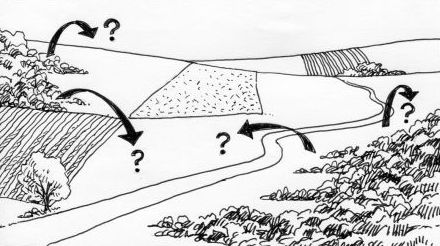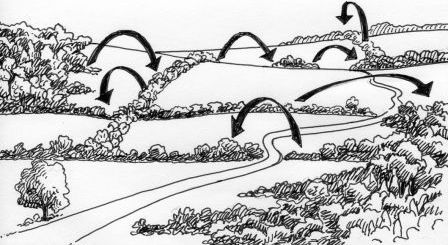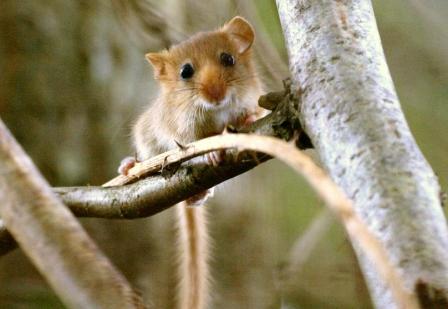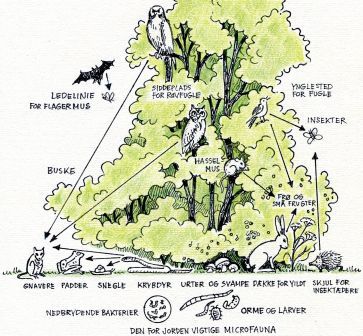A collaboration project between Denmark and Germany is bracing animals and plants for climate change.
Networks of hedges and small biotopes such as lakes and copses are not only beautiful to see in the landscape and an efficient way of marking the boundary line between fields. They also serve a special purpose as habitat corridors for animals and plants, particularly in places where natural areas have been divided or fragmented in one way or another.
About 60% of Denmark's total area is arable land, and about 10% is paved and built-up. In many places this creates a marked division of Danish nature, as the areas of land in between natural areas are often used for intensive agriculture, technical installations, roads and villages. Hedges and small biotopes are therefore important for biodiversity in Denmark. They work as important corridors and stepping stones for isolated species and are vital for the migration, spread and genetic exchange of species.
Furthermore, new research stresses that establishing and protecting corridors, hedgerows and cohesive natural areas is one of the most effective types of climate change adaptation in relation to ensuring biodiversity in the landscape during a changing climate. Rising temperatures and more extreme weather events may pose a very real threat to small isolated populations and mean that habitats for some species disappear entirely, while other species crop up. Better cohesion between natural areas helps secure the mobility of species and thereby their adaptation to these new conditions.
However, the number of hedgerows has fallen and, to a great extent, peaked within the last 50 years because fields and agriculture have been merged.

How are species supposed to move around in the open countryside when climate change is destroying their habitat? (Drawing: Birgitte Flarup based on an original by Biologforbundet (association of Danish biologists))
Therefore, the Danish Nature Agency, Funen and South Jutland and two partners from Schleswig-Holstein, Stiftung Naturschutz and Landesforst, have established a joint EU INTERREG project called BioGrenzKorr.
BioGrenzKorr is an abbreviation of 'development and sustainable utilisation of cross-border wood and landscape corridors for biological diversity'. The purpose of the BioGrenzKorr project is to develop, test and communicate methods to maintain hedgerows and corridors, focusing on securing biodiversity and on sharing knowledge and experience across borders. This will primarily be done by managing habitats for selected key species linked to hedges and forest such as common dormouse, birch mouse and bats.
Maintaining old hedges and establishing new hedges promote climate change adaptation.
It is estimated that there is about 80,000 km of hedgerows in Denmark of very variable quality and value as biological corridors. Hedgerows often benefit most from biodiversity, if they are maintained by coppicing every 10-15 years. Active maintenance is required, if the ecological functions of hedges are to be optimised in order to conserve biodiversity.
Trees and shrubs in these hedgerows reshoot from the stumps, and the hedges will already be green by the following growing season. Species like ash, elm, hazel and common alder shoot up to one metre in the first year. In coppice forests on Funen in Denmark, 80 different trees and shrubs that can tolerate this method have been registered. Coppicing (cutting back) creates special dynamics in the hedges, allowing great variation in the biodiversity:
- Regeneration in connection with coppicing means that trees and bushes get very old, and that the stumps can have several stages of rot that benefits fungi and insects. Perhaps the ground has remained untouched for several centuries; in contrast with to the surrounding agricultural land. This creates biotopes for other species of insects, fungi and seed pools. This also provides space for hibernation for a variety of species, such as amphibians, insects and smaller mammals.
- Coppicing intervals of 10-20 years cause relatively little disturbance in the hedgerows.
- The flora develops in line with the changing character of the hedges. After coppicing, light-demanding herbs emerge, which are later displaced by shrubs and trees as they grow and provide shade. Habitats for different insects as well as other species of animals are linked to the different stages of the hedge's development.
If the hedges are not coppiced, the number of species is likely to decrease over time, as the dynamics created by coppicing, cease to exist and no longer make room for the species connected to this newly coppiced hedge.
In Schleswig-Holstein hedges are specially protected, and are maintained by coppicing at intervals of 10-15 years, retaining single trees every 20-50 metres. Experience from Germany is therefore an important source of inspiration for Danish projects.
When establishing new hedgerows, the most important aspect with regard to biodiversity is to create corridors to other natural areas. This enables biodiversity to spread from one natural area to another during changing climate conditions. When sensitive species can spread to new areas, they become less sensitive to changes in the landscape as well as in the climate and therefore have a greater chance of surviving. It takes many years to build up the biodiversity found in the old hedgerows, and therefore it is difficult to measure the direct effect in new hedges within the relatively short BioGrenzKorr project period of two years. However, new research has documented a positive effect for biodiversity within five years after new corridors have been established.

Hedges provide emigration possibilities for plants and animals when local conditions are deteriorating due to climate change (Drawing: Birgitte Flarup based on an original by Biologforbundet (association of Danish biologists))
Expected effect of the project for rare key species
The small mammals, common dormouse and birch mouse, which are key species in the project, as well as several bat species, are rare and are protected by the EU Habitats Directive Annex IV. The endangered common dormouse is particularly suitable to use in the BioGrenzKorr project, because it only moves from one area to another if it can find cover in dense scrub vegetation with food. It will never cross over an open field. The core areas of the common dormouse in Northern Germany and in Denmark are small biotopes, hedges and forests with many different species. The habitats of the common dormouse must be overgrown and integrated with other hedgerows, small biotopes or forests.
Habitats of the common dormouse are therefore very dynamic and change over time from being suitable habitats to being unsuitable. The population of the mouse is considered endangered, and can probably be made more robust in the long term, if habitats are connected with neighbouring areas in which new populations can be established. Such cohesive landscapes are also of great benefit to many other animals, plants and insects which are provided with better opportunities to spread to more suitable habitats. They also have better opportunity to adapt when climate change makes current habitats uninhabitable and depletes food sources. Several bat species are also expected to benefit from the project.

Common dormouse (Photo: Björn Schulz)
If the BioGrenzKorr project is successful and contributes to more active management by landowners and nature managers of corridors in forests and in the open countryside, this will result in better preservation of habitats for many endangered species in Denmark and Schleswig-Holstein.
Costs and budget
So far, active maintenance of hedgerows has been relatively expensive. Therefore, the goal of the Danish part of the project is to develop and test cheap and practical nature-maintenance methods which also generate revenues from sales of fuel from the hedges, so they can be used on private properties. In this way, the project can make establishing green corridors more attractive to landowners.
The Danish Nature Agency has also established a new funding scheme for special operation of forests with a view to protecting the habitats of the common dormouse and bats and encouraging them to spread in forest areas.
BioGrenzKorr is being funded by EU Structure Funds through the INTERREG IVA scheme, administered by South Denmark Region. The project was launched in 2010 and will run until June 2013 with a budget of almost DKK 3 million for the Danish part and a total budget of about DKK 4,125,000 million.

Hedges can create habitats for a spectrum of animal and plant species (Drawing: Birgitte Flarup based on an original by Biologforbundet (association of Danish biologists))

Other publications available here.